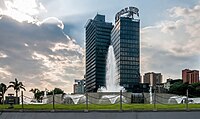
Lifestyle-tailored interventions for South Asians with type 2 diabetes living in high-income countries: a systematic review
Sign Up to like & getrecommendations! Published in 2017 at "Acta Diabetologica"
DOI: 10.1007/s00592-017-1008-8
Abstract: AbstractAimTo summarize evidence on the effectiveness of educational interventions for type 2 diabetes control in South Asians living in high-income countries. MethodsWe systematically searched PubMed, EMBASE, Cinahl and the Cochrane Library, using Medical Subject Heading… read more here.
Keywords: high income; south asians; living high; type diabetes ... See more keywords

A prospective cohort study about the effect of repeated living high and working higher on cerebral autoregulation in unacclimatized lowlanders
Sign Up to like & getrecommendations! Published in 2022 at "Scientific Reports"
DOI: 10.1038/s41598-022-06270-z
Abstract: Cerebral autoregulation (CA) is impaired during acute high-altitude (HA) exposure, however, effects of temporarily living high and working higher on CA require further investigation. In 18 healthy lowlanders (11 women), we hypothesized that the cerebral… read more here.
Keywords: high working; exposure; working higher; cerebral autoregulation ... See more keywords

Cancer antigen-125 levels correlate with pleural effusions and COPD-related complications in people living at high altitude
Sign Up to like & getrecommendations! Published in 2018 at "Medicine"
DOI: 10.1097/md.0000000000012993
Abstract: Abstract Chronic obstructive pulmonary disease (COPD) is the most frequently encountered progressive lung disease in clinical practice. This study sought to determine the predictive ability of the tumor biomarker cancer antigen-125 (CA-125) in the identification… read more here.
Keywords: antigen 125; living high; high altitude; 125 concentrations ... See more keywords

Impact of lead exposure on the thyroid glands of individuals living in high- or low-lead exposure areas
Sign Up to like & getrecommendations! Published in 2023 at "Medicine"
DOI: 10.1097/md.0000000000033292
Abstract: Ecuador was an endemic area for iodine deficiency; however, due to the population consumption of iodized table salt, the country is nowadays considered iodine sufficient. Despite the population consumption of iodized salt for more than… read more here.
Keywords: thyroid; individuals living; exposure areas; living high ... See more keywords

Positive end-expiratory pressure and risk of postoperative pulmonary complications in patients living at high altitudes and undergoing surgery at low altitudes: a single-centre, retrospective observational study in China
Sign Up to like & getrecommendations! Published in 2022 at "BMJ Open"
DOI: 10.1136/bmjopen-2021-057698
Abstract: Objectives To examine whether a high positive end-expiratory pressure (PEEP ≥5 cmH2O) has a protective effect on the risk of postoperative pulmonary complications (PPCs) in a cohort of patients living at high altitudes and undergoing… read more here.
Keywords: peep; patients living; risk; living high ... See more keywords

Associations between waist circumference and executive function among Chinese Tibetan adolescents living at high altitude
Sign Up to like & getrecommendations! Published in 2023 at "Frontiers in Nutrition"
DOI: 10.3389/fnut.2023.996785
Abstract: Background Associations between body composition and execution function (EF) were currently studied in low altitude (LA) areas. However, the research on the correlation between waist circumference (WC) and EF among adolescents living at high altitude… read more here.
Keywords: chinese tibetan; adolescents living; living high; tibetan adolescents ... See more keywords

Breathing Patterns and Oxygenation Saturation During Sleep in Children Habitually Living at High Altitude in the Andes: A Systematic Review
Sign Up to like & getrecommendations! Published in 2021 at "Frontiers in Pediatrics"
DOI: 10.3389/fped.2021.798310
Abstract: Background Human respiratory physiology changes significantly in high altitude settings and these changes are particularly marked during sleep. It is estimated that 170 million people live above 2,500 m in environments where normal sleep parameters… read more here.
Keywords: age; physiology; systematic review; living high ... See more keywords

Physiological Adaptations to Hypoxic vs. Normoxic Training during Intermittent Living High
Sign Up to like & getrecommendations! Published in 2017 at "Frontiers in Physiology"
DOI: 10.3389/fphys.2017.00347
Abstract: In the setting of “living high,” it is unclear whether high-intensity interval training (HIIT) should be performed “low” or “high” to stimulate muscular and performance adaptations. Therefore, 10 physically active males participated in a 5-week… read more here.
Keywords: intermittent; muscle; living high; training ... See more keywords

The impact of COVID-19 on populations living at high altitude: Role of hypoxia-inducible factors (HIFs) signaling pathway in SARS-CoV-2 infection and replication
Sign Up to like & getrecommendations! Published in 2022 at "Frontiers in Physiology"
DOI: 10.3389/fphys.2022.960308
Abstract: Cases of coronavirus disease 2019 (COVID-19) have been reported worldwide. However, one epidemiological report has claimed a lower incidence of the disease in people living at high altitude (>2,500 m), proposing the hypothesis that adaptation… read more here.
Keywords: hypoxia; covid; living high; cov infection ... See more keywords

Resistance training exercises for obese and non-obese individuals living in high-altitude regions utilizing biochemical markers—A controlled trial
Sign Up to like & getrecommendations! Published in 2021 at "Nigerian Journal of Clinical Practice"
DOI: 10.4103/njcp.njcp_277_19
Abstract: Background: High-altitude disease prevalence varies according to types of exposure and the effects of hypoxic and hypobaric environments, with the result that people at high altitudes present many different physiological responses. Aims: The research aims… read more here.
Keywords: resistance training; training exercises; living high; high altitude ... See more keywords